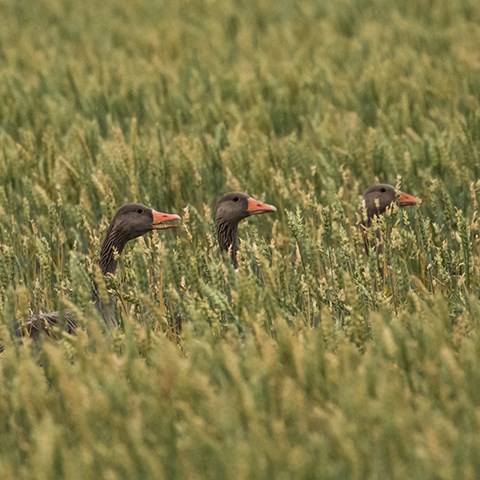Reporting crop damages caused by geese and cranes for a better protection of crops in the future

Farmers, researchers and wildlife managers need to work together. Without farmers reporting where geese and cranes cause damage, researchers and wildlife managers are blind to design or to assess strategies for crop protection. SLU researchers suspect that not all damages are reported today and urge farmers to use the system.
Geese and cranes tend to concentrate in huge numbers in agricultural wetlands where they roost every evening, foraging on the surrounding crops. What ultimately restricts the amount of birds on a roosting site is the amount of food available within approx. 10km radius. Geese and crane populations have dramatically increased in Europe since the last 50 decades due to higher conservation measures (species protection, wetland restoration and refuge creation) but also, the agricultural intensification that occurred in mid-50s and 60s and nowadays warmer climate. Agricultural intensification ensures high quality of food all year around up to the point that geese and cranes, that are extremely opportunistic and with a high mobility and capacity to optimize the resources, have significantly switched their foraging behavior from natural to agricultural fields.
Higher number of birds, higher number of crop damages?
As numbers of birds increase, conflicts between conservation efforts and farming activities arise, especially when it involves restoration of farmland wetlands for nutrient retention and conservation of biodiversity.
Higher number of birds potentially leads to higher number of crop damage and higher amount of yield loss. However, annual increase of geese and cranes does not necessarily translates into immediate higher amount of crop damage.
The high opportunistic foraging behavior of these birds can cause sudden bursts of damages when local food availability and foraging conditions change due to weather, local farming practices or management actions for crop damage prevention. Furthermore, it seems that the conflicts with some of these species could be developing at new places as bird numbers increase, which ultimately may increase costs for compensation and damage prevention.
Mitigating crop damage by large grazing birds in Sweden
In Sweden, crop damage is mitigated by facilitating communication between farmers and managers of the County Administrative Boards (where farmers can report crop damage if they want compensation) and implementing measures at the local scale to prevent damage such as scaring, establishing diversionary fields and occasionally, derogation shooting. Management efforts for preventive measures have increased since 2002. In 2017, the Swedish Government spent 11.3 million SEK on economical compensations for yield lost and crop protection caused by geese and cranes (Viltskadestatistik, 2017). However, many of the methods used today as local measures for crop damage prevention such as scaring devices, have little or no research to support them. In addition, geese get used to scaring devices that have been used repeatedly and this calls for innovative and new scaring measures.
Working together to fill knowledge gaps
We need to identify where and when crop damage occurs, which species are causing it and which crops are at higher risk. We also need to understand why crop damage occurs and how it varies across Sweden to tailor crop protection strategies.
In addition, we also need to get a clearer picture of how effective different scaring methods really are, test new ones (such as drones) and know what the geese and cranes do after they have been scared (for example, do they fly to the next field and continue foraging there or do they come back to the same field and if so, how long does it take before they return to the same field?). Then we can get an idea of whether there is any difference between the different scaring methods and when and where those methods need to be focused”, says Malin Teräväinen, PhD student at SLU.
To help filling all these gaps, we need the farmers to report crop damages at the County Administrative Board. Only then we, researchers, will be aware of the actual damage levels (how many farms are affected, where and when, loss of yield, costs, which species, crop types and fields are involved) and will be able to develop the most effective preventive methods.
Today, the researchers believe that not all damages are reported and that there is an important piece missing when it comes to communication between researchers, County Administration Board and farmers. Team work between farmers, managers and applied ecology researchers is crucial to develop successful actions for crop protection.
Links
Read more
Relating national levels of crop damage to the abundance of large grazing birds: Implications for management, Journal of Applied Ecology
().
